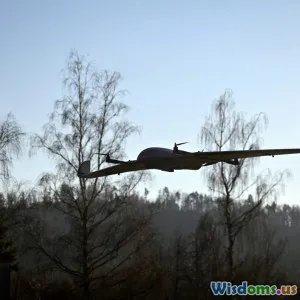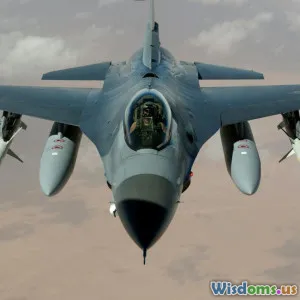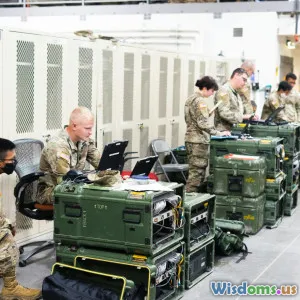
Lessons Learned From Recent Drone Swarm Attacks
10 min read An in-depth analysis of drone swarm attacks reveals critical strategic and technological lessons for modern defense and security. (0 Reviews)
Lessons Learned From Recent Drone Swarm Attacks
Introduction
Drones, once considered novel tools for hobbyists, have rapidly evolved into powerful instruments of warfare and disruption. Over the last few years, the world has witnessed an unsettling increase in the use of drone swarms to carry out coordinated attacks against military installations, critical infrastructure, and even civilian targets. These attacks have challenged traditional defense systems and underscored vulnerabilities in national security.
The complexity of swarm tactics—where multiple drones operate cooperatively under a unified command—creates significant challenges for detection, tracking, and neutralization. By examining recent drone swarm incidents, we can uncover key lessons that aid in shaping more resilient defense strategies, enhance technological responses, and better prepare for future threats.
This article delves deeply into the multifaceted lessons derived from recent drone swarm attacks, drawing from real-world examples and expert analysis to provide insights that inform policymakers, defense analysts, and security professionals.
Understanding Drone Swarm Attacks
What Constitutes a Drone Swarm?
A drone swarm refers to a group of drones that are networked to act cohesively, often autonomously, to achieve a common objective. Unlike isolated drones, swarms leverage collective behavior to overwhelm defenses by attacking simultaneously from multiple vectors or coordinating for varied roles such as surveillance, disruption, or kamikaze payloads.
Recent Examples of Drone Swarm Attacks
-
The 2020 Nagorno-Karabakh Conflict: Swarm attacks effectively used by Azerbaijani forces disrupted Armenian air defenses and neutralized armored formations. The tactics demonstrated the value of drone swarms in asymmetric warfare.
-
Saudi Oil Facilities Attack (September 2019): Around 20+ drones reportedly coordinated in strikes against Aramco oil processing plants, halving Saudi Arabia’s oil output temporarily. The sophistication highlighted drone swarm vulnerabilities in critical energy infrastructure.
-
Ukraine Conflict (2022-2023): Ukrainian forces deployed swarms to target Russian supply lines and artillery, while Russian forces adapted counter-drone techniques in response. Multiple drone swarm uses highlighted the tactical flexibility and evolving technology.
Key Lessons from Recent Drone Swarm Attacks
1. The Importance of Early Detection and Multi-Layered Defense
Drone swarms typically exploit gaps in traditional radar and sensor coverage due to their small size, low radar cross-section, and use of low-altitude or terrain-masking flight paths.
Lessons:
- Developing highly sensitive detection layers, integrating electromagnetic, acoustic, and infrared sensors, is essential.
- Deployment of mesh networked sensors and artificial intelligence (AI) for anomaly detection improves response time.
- Layered defense including electronic warfare, kinetic interceptors, and directed energy weapons enhances neutralization success.
For instance, Israel developed hostile drone neutralization systems post-Hamas drone attacks, utilizing radar detection combined with anti-drone guns and jammer systems, effectively reducing the threat.
2. Swarm Behavior Requires New Tactical Approaches
Handling a swarm differs fundamentally from confronting a single drone. Traditional air defense designed to intercept single targets can be overwhelmed by multiple, simultaneous incursions.
Lessons:
- Prioritize counter-swarm tactics like jamming communication frequencies linking drones to disrupt swarm coordination.
- Invest in autonomous defense systems capable of rapidly targeting and prioritizing threats.
- Use of counter-swarms—groups of drones tasked with intercept roles—offers a mobile, adaptable method.
During the Nagorno-Karabakh conflict, the lack of electronic warfare against drone coordination demonstrated vulnerabilities; various forces are now focusing on jamming and hacking swarm control signals.
3. Vulnerabilities in Commercial Off-The-Shelf (COTS) Technology
Many swarms leverage readily available commercial drones, adapted with custom firmware or payloads, making them accessible to a broad range of actors.
Lessons:
- COTS technology blurs the line between conventional military hardware and accessible technology, complicating regulation and control.
- Security must extend to cyber defenses that protect drone firmware from capture or misuse.
- Law enforcement and military entities must anticipate dual-use technology becoming a vector for swarm deployment.
Examples from Middle Eastern conflicts reveal how inexpensive drones adapted from commercial platforms created effective, affordable swarm units.
4. The Proliferation and Democratization of Swarm Technology
The spread of open-source software and modular hardware enables non-state actors and smaller military forces to deploy swarms effectively.
Lessons:
- Intelligence agencies must monitor technological diffusion carefully.
- Investment in training and doctrine development for swarm warfare prepares national forces.
- International cooperation to control proliferation through export controls and sanctions may help mitigate risks.
5. Effective Use of AI and Machine Learning
AI enhances swarm coordination, enabling autonomous decision-making and adaptability, resulting in more resilient and unpredictable swarm tactics.
Lessons:
- Defense systems must incorporate AI to keep pace, employing machine learning to recognize and predict swarm behavior.
- Research into defensive AI that autonomously prioritizes threats and coordinates multi-platform responses is crucial.
The 2022 drone swarms seen in Eastern Europe revealed real-time AI usage to adapt flight paths and evade interception measures.
6. Integrating Cross-Domain Defense Strategies
Drone swarm attacks often coincide with cyberattacks, electronic warfare, and kinetic strikes, indicating increasingly complex hybrid tactics.
Lessons:
- Defense requires integrated cross-domain strategies, combining cyber defense, electronic warfare, and aerial systems.
- Sharing intelligence quickly across agencies and allied forces maximizes preparedness.
- Recognize the dynamic nature of swarm attacks that may evolve rapidly and in unpredictable ways.
Impact on Future Security and Defense Planning
Implications for Military Strategy
The drone swarm phenomenon demands a paradigm shift in military doctrine—emphasizing agility, distributed command, and decentralized defense.
- Armies are increasingly establishing dedicated drone defense units and enhancing their electronic warfare capabilities.
- Training must focus on swarm recognition, threat assessment, and rapid adaptive response.
Implications for Civilian Security
Critical infrastructures such as energy grids, airports, and urban centers become prime targets for swarm attacks.
- Investment in civilian critical infrastructure protection, including drone detection systems and rapid response protocols, is essential.
- Public-private partnerships can promote better threat awareness and technological deployment.
The Ethical and Legal Challenges
Use of autonomous swarms raises questions around accountability, especially where civilian casualties or collateral damage occur.
- There is a need for development of international norms governing drone swarm engagement.
- Balancing technological advancement with ethical frameworks must be prioritized by governmental and international bodies.
Conclusion
Recent drone swarm attacks underscore a new era in warfare and security challenges. They reveal critical lessons in detection, defense strategy, technological vulnerabilities, and the evolving nature of conflict. As drone swarm capabilities spread rapidly, nations and organizations must deepen their understanding and adopt integrated, tech-savvy, and flexible defenses.
From enhancing sensor networks and leveraging AI to developing cross-domain strategies and addressing ethical questions, the path forward demands agility and foresight. The future security landscape depends on our ability to learn from recent experiences, innovate accordingly, and build resilient infrastructures to mitigate the rising threat of drone swarms.
Encouraging ongoing research, international cooperation, and infrastructure investment are paramount steps toward robust preparedness in the age of drone swarm warfare.
Author’s note: Staying informed about emerging drone technologies and threat patterns empowers decision-makers and security professionals. Understanding these lessons provides a foundation to shape policies that protect people, infrastructure, and national security in an increasingly drone-enabled future.
Rate the Post
User Reviews
Popular Posts




















